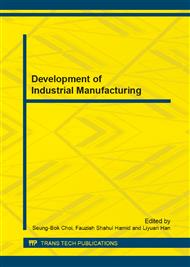[1]
Meizhong Shi, Zhongzheng Wang. Principle and design of heat exchanger (Fourth Edition), Nanjing: Southeast University press, (2009).
Google Scholar
[2]
Jianfeng Qian, Yankun Tan, Jili Zhang. Sewage source heat pump system with acoustic cavitation cleaning technology of enhancing heat transfer of [J]. Building energy & Environment, (2011).
Google Scholar
[3]
Yanshuo Jiang, Yiming Li. Industrial application of ultrasonic anti-fouling technology [J]. energy saving, (2010).
Google Scholar
[4]
Na Qin. Untreated Sewage Turbulent Characteristics and the Research on Heat Pumps Using Untreated Sewage as the Heat or Cold Source [D]. Master's thesis, College of environmental science and engineering, Tianjin University, (2010).
Google Scholar
[5]
Jun Wang, Jiantao Han, Yang Zhang. The application of ultrasound technology in chemical production. Contem porary Chemical Industry[J] (2002).
Google Scholar
[6]
Zhi Lu, Ye Yao and Zhiwei Lian. Application of Ultrasonic Technique in HVAC&Field. Building Energy&Environment[J]. (2007).
Google Scholar
[7]
Chengcan Yao. Research on ultrasonic to prevent scale formation solution evaporation process[D]. Guangzhou: South China University of Technology, (2000).
Google Scholar
[8]
Taiqiu Qiu, Ying Xiang, Haiqin Lu, etc. Mechanism of Scale Controlling of Heat-Transfer Equipment by Ultrasonic[J]. Journal of South China University of Technology, (2006).
Google Scholar
[9]
Nomura S, Murakami K. Influence of Straeming Induced by an Ultrasonic Vibration on Heat Transfer. In: Proceedings of 36th Symposium on Heat and Mass Transfer of the Japanese Society of Engineering Thermophysics, (1999).
Google Scholar
[10]
Xili Duan, Xuanying Wang. Experimental study on the influence of ultrasonic vibration on heat transfer and pressure drop in heat exchanger tubes [J]. Journal of Petrol-chemical equipment, (2004).
Google Scholar
[11]
D W Zhou, D Y liu. hear transfer Characteristics of Nanofluids in an Acoustic Cavitation Field. Heat Transfer Engineering, (2004).
Google Scholar
[12]
Guchuan Nie, Ricong Nie. Application of ultrasonic antiscaling and descaling technology on heat exchange equipment [J]. Chlor-Alkali Industry, (2012).
Google Scholar


